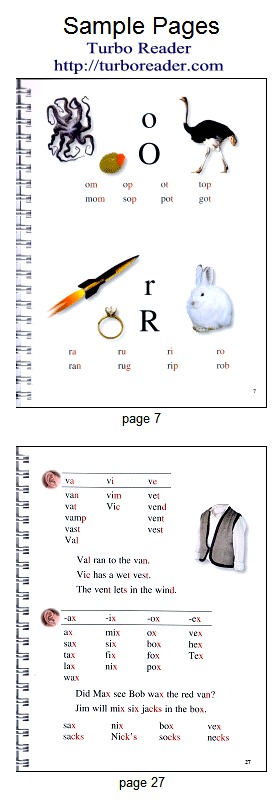
Teaching Pre-school Children To Read At Home.
Review of the Popular
Turbo Reader Curriculum and Related Resources.
There's a strong argument suggesting that parents should teach children to read before they're sent to public school.
The statistics are self-evident. Forty to forty-five percent of the children who enter public school each year will not learn to read. These unfortunate persons migrate upward through the system and after 10 or 11 years they usually drop out of school and take a low-paying job that doesn't require reading skill.
A student in San Francisco gained notoriety a few years ago when he sued the school district upon graduation. His complaint was based on the fact that he couldn't read.
If a person hasn't learned to read by the end of 2nd grade, he or she becomes highly "at risk" of dropping out a few years later. Upon reaching 9th grade such persons are typically two years older than their classmates because they may have been held back one or two grade levels along the way.
As of 2008 the U.S. had over 40 million residents who were unable to compare two newspaper ads to identify the better product, or were unable to read medicine labels adequately to be sure of recommended dosages.
 Additionally, bilingual classes in many schools simply keep students active with the language of their birth, never promoting English as necessary for a productive life. In 1993 an airplane pilot qualified his language tests, certified as adequately bilingual. He was flying a U.S.-made MD-80. When attempting to land he was baffled by an audio recording, an alarm telling him what to do. His last words to the tower were "What does 'pull up' mean?"
Additionally, bilingual classes in many schools simply keep students active with the language of their birth, never promoting English as necessary for a productive life. In 1993 an airplane pilot qualified his language tests, certified as adequately bilingual. He was flying a U.S.-made MD-80. When attempting to land he was baffled by an audio recording, an alarm telling him what to do. His last words to the tower were "What does 'pull up' mean?"
Children, however, can by-pass this entire illiteracy threat if they're taught to read at age 4 or 5 before they enter school. Some parents even delay their child's entrance to public school until they're sure the child is reading beyond the first grade level.
A long-time public advocate of this strategy is Phyllis Schlafly. She taught six of her own children to read, developing her own phonics teaching materials along the way. They were soon published in 1994. Her curricular materials have been widely used since then by home-schooling-parents and also by literacy volunteers who sometimes assist after hours in public schools offering remedial classes in reading. See the inset above.
The site for reviewing the Turbo Reading materials is at http://TurboReader.com .
 Whereas this American Literacy Site often documents how difficult it is to lead adults to literacy - referring mostly to immigrants, or adults who dropped out of school, Phyllis Schlafly puts forth a strong opposite argument, stating that you can't believe how easy it is to teach a four-year old child how to read.
Whereas this American Literacy Site often documents how difficult it is to lead adults to literacy - referring mostly to immigrants, or adults who dropped out of school, Phyllis Schlafly puts forth a strong opposite argument, stating that you can't believe how easy it is to teach a four-year old child how to read.
Even if you're working two jobs or you're in a single-parent situation, you can teach a child to read in just a few months using time that you would normally spend with the child in any case.
All you need are phonic teaching materials designed for the child's level. The "Turbo Reader" package consisting of three books or booklets is her answer with thousands of testimonials regarding their effectiveness. It's a cook-book approach. Just do what the curricular guide instructs you to do as a parent.
An 8th grade teacher called into a radio program, complaining that half her 8th grade students can't read. Therefore the school administration requires her to accommodate those students by reading test questions aloud to the students - even when the test was designed as a written test.
At other times she has to record test questions on audio cassettes so that students can listen to the questions. She's told to give more test-time to illiterate students that to others, and allow them to turn in late papers.
She stated that she cuts 1/3 of the subject matter from 8th grade science because the reading difficulties are so severe.
Think ahead. If you have a child below age 6 and you never want the heartache of a future 8th-grader who can't read, take a little time and consider the wisdom of teaching your child to read using materials like these shown here.
For parents who choose to use the Turbo Reader materials, note that the ALC Sound-Write software is available without cost. It can be used as a supplemental tool with the Turbo Reader curriculum and booklets It's described on a separate web page and can be downloaded after reviewing the information there:
Sound-Write Software 
Sound-Write software enables your computer to speak English words as they are typed. It corrects 90% of all misspelled words. Words can be re-spoken to the student - individually or in sentence form - over and over for student practice in hearing the so-called normal sound of selected English words and sentences. It also corrects "invented spellings" on the fly - even for beginning ESL students.
Better yet, see the full-blown new "Experimental Computer-assisted Phonic Learning Strategy" for any age level, presented here: Computer-assisted Reading Curriculum for Students of Any Age.